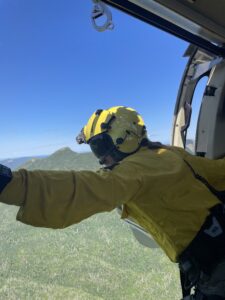SLK gets grant for new equipment
Electric equipment to improve capacity, revenue, safety

This “experienced” tug at the Adirondack Regional Airport will be replaced through a $377,100 state grant with a 10% match from Harrietstown. (Provided photo — Corey Hurwitch)
LAKE CLEAR — The Harrietstown-owned Adirondack Regional Airport received a $377,100 state grant for new electric ground service equipment on Monday.
Airport Manager Corey Hurwitch said the three pieces of equipment he’ll buy — an electric aircraft push-back tractor, an electric luggage belt loader and a set of towable air stairs — will allow the airport to take in more planes and larger planes, produce more revenue, make loading and boarding safer for staff and passengers and replace outdated equipment with greener alternatives.
The grant, through the AIR NY Aviation Capital Grant Program, requires a 10%, $41,900, match from the town. The total cost of the project is $419,000.
The airport has several aircraft push-back tractors — also commonly known as “tugs.” Hurwitch called their oldest one “very experienced,” to put it nicely. It is hard to find parts for and it doesn’t have power steering, which makes maneuvering tight turns difficult.
Just the cost of buying a new tug alone would be more than the town’s share of this grant, Hurwitch said. The belt loader and stairs are gravy. He said the grant gets them more equipment, green equipment and costs the town less.
Hurwitch said it’s getting harder to reach cargo holds on larger business jets. Currently, employees stand on ladders and twist and turn while loading or unloading heavy bags. It’s dangerous. A belt loader will make their job less injury-prone.
The air stairs will also allow the airport to accept more business jets and charter flights.
“Last year, we had a customer with a Boeing business jet who had to deplane via a big ladder,” Hurwitch said. “It’s kind of comical but kind of embarrassing. To see this large business jet on our ramp and not be able to safely handle the passengers.”
The airport has had to turn away some charter flights because not all of them have their own onboard stairs. This is lost revenue. And these missed flights are some of the biggest ones. One of these flights alone could include a 5,000-gallon fuel sale.
Hurwitch said private flights subsidize the public use of the airport. For every private jet landing, the airport sells fuel and charges fees for landing, hangar stays and ramp usage. These revenues keep the operating cost of the airport manageable and financially efficient, he said.
The new tug should be able to handle most of the aircraft they handle, Hurwitch said — up to Global and Gulfstream business jets. Instead of diesel, it will be electric. Hurwitch said this helps them on their sustainability and green initiatives. The model he’s looking at will be compatible with the airport’s existing electric infrastructure.
Hurwitch said he hopes to get the equipment by the busy season next summer.
The airport made its grant application in January. Hurwitch said the turnaround on this award was faster than state grants have been recently.




